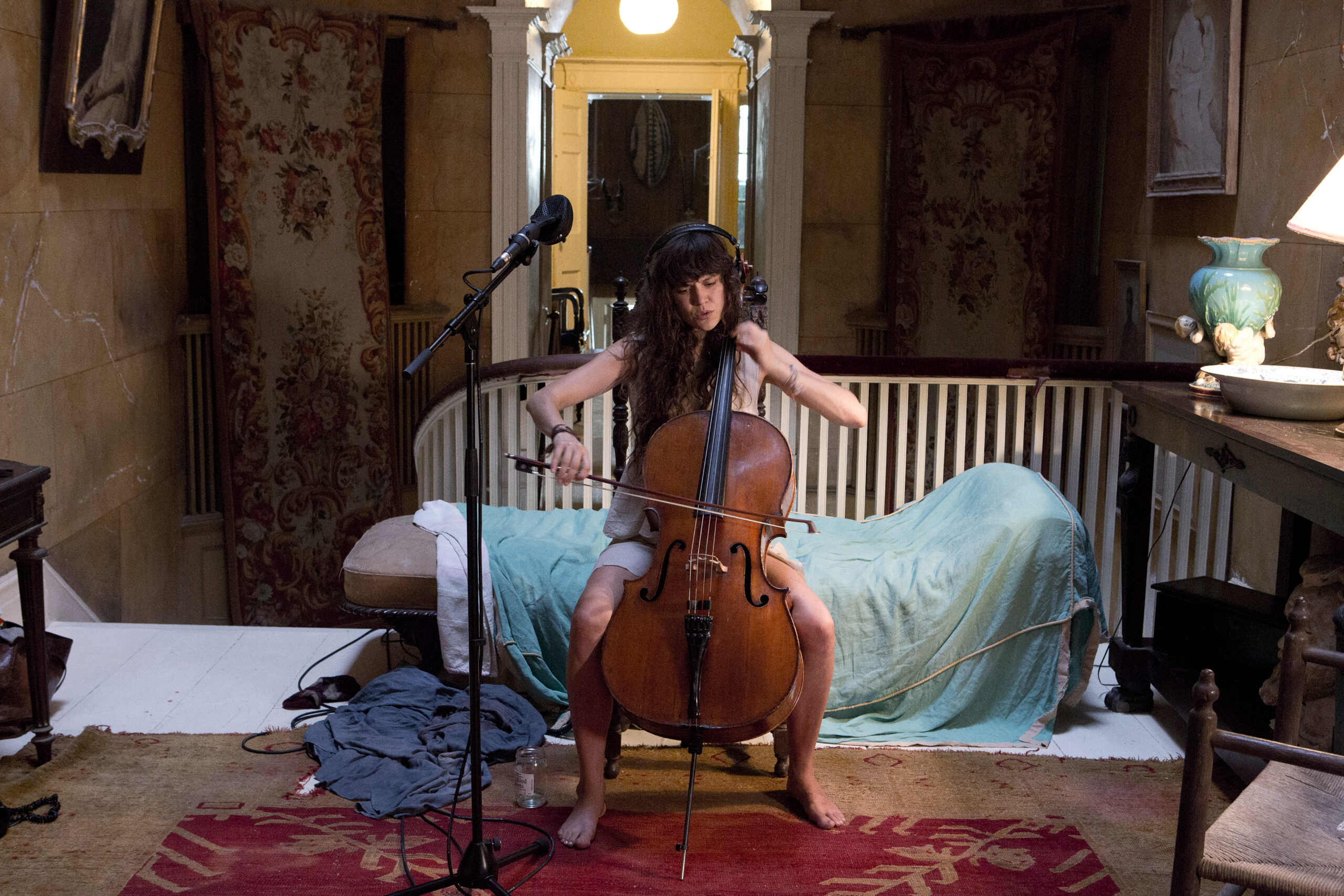
On a Saturday this July, I sat through three runs of Ragnar Kjartansson’s video installation, The Visitors, at the San Francisco Museum of Modern Art. I had imagined transcribing some of what I overheard from other patrons, but in the three-plus hours I was there (The Visitors has a 64-minute run time), no one spoke. No one even pulled out their phones, except to film short segments of the videos projected onto the gallery room’s walls.
While I was there, I saw one man in a crisp navy suit walk in alone. Before he had taken five steps into the exhibit room, he gasped, clutched both hands over his heart and started crying with an open-mouth grin plastered on his face. I watched as he slowly walked toward the center of the gallery and then, spreading his arms out beside him as though readying himself to hug a beloved, he began to spin, his chin bobbing from silent laughter, tears still streaming down his face. Another man, also alone, stood unmoving in front of one of the nine screens for the entire length of the performance, moving only once to remove his glasses and wipe tears from the crests of his cheeks. A girl who looked about 13 sat through two performances with a man who was the right age to be her father. When the music swelled halfway through the performance, she spun to face him and then tapped on his hand a few times. He smiled down at her with an eager, almost confused expression until finally she grasped his hand and they stayed like that for the rest of the hour: shoulder to shoulder, fingers locked, looking together at the same screen. It was, in other words, a totally average afternoon in The Visitors gallery.
The Visitors was commissioned for the Migros Museum für Gegenwartskunst in Zurich in 2012. It is, per The Guardian in 2019, the best 21st-century artwork of any medium from anywhere in the world. But even this oversized accolade is outshone by its cultish popular appeal. There are dozens of Reddit threads about it, populated by users advising each other to set up Google Alerts set to the artist’s name so as to be notified every time there’s a new installation. An alert, here, for those reading: after three years at SFMOMA, it will be taken down Sept. 28 this year. Experience it while you can.
On YouTube, a full-length recording of the installation has over 1,000 comments, every single one positive. People write of traveling internationally year after year to see it in each new country where it’s shown. (The work has been exhibited in over a dozen countries.) “This piece changed my life,” several people, just in the first page of comments, say. One commenter had a meet-cute in the gallery that turned into a whirlwind romance—one of the most impactful of their life. Another muses that “the people involved in this piece are among the luckiest people who ever existed on this planet.” There is a common refrain among these reflections: a person shows up in a gallery, having never heard of the work, and spends an hour or more crying while taking it in. When they eventually leave the room, they feel permanently changed.


That The Visitors so effectively functions as a magic trick is not revealed immediately; at first glance, the show seems like a glorified jam sesh among a bunch of supremely talented early-middle-aged friends. The piece has nine video channels, each shot simultaneously in several rooms of Rokeby Mansion in upstate New York. Each screen focuses on a different musician. There’s a cellist, two pianos, electric guitars—everyone is out of sight from each other, connected only by headset monitors. A choir is gathered under string lights on the mansion’s porch, smiling and laughing and occasionally entering the piece with harmonies that would be at home in a gospel song. Among the performers is Kjartan Sveinsson, a former member of Sigur Rós and a frequent collaborator with Kjartansson. “I was really creating my dream band from the Reykjavik music scene. Everyone in there is a legend or a friend,” Kjartansson, who is Icelandic, has said.
Iceland is, if anything, obsessed with a self-assigned sense of misfittedness, and this national anti-identity is a hallmark of the nation’s art. “In Iceland, there’s this idea that we don’t really belong in the world, this country in the middle of the ocean and so far from other countries,” the artist further elaborated.
“Have you been to Iceland?” the poet Anne Carson asks in the liner notes of a limited-edition vinyl recording of the performance. “There is nothing there but emptiness. A gigantic empty wind wails along the very edge of every minute and tosses the odd dazed seabird out onto the empty beach. When you drive the single lonely highway, a huge piece of emptiness drives along beside you and goes wherever you go, then piles up in your driveway at home on top of the emptiness from other days. You see horses standing in the fields so soaked with emptiness they can’t move, they’ve been there for years, they might as well be waterfalls. Of course, all of this exerts a psychic pressure on inhabitants—the whole soul frays.”
It is a country of outlaws. “There is even a statue of the Outlaw in Reykjavík, next to the National Museum—and the idea of the outlaw here is similar to the idea of the artist. I think making art comes from being a little allergic to society, not wanting to belong.” And so this work is set in the verdant isolation of upstate, which has its own legacy as being a place to run away. But what exists at the far end of any great escape, if not utopia? That’s what the piece is really about: the seductive promise of belonging.
But the fine print of belonging reveals that it is not a passive enterprise but rather an endeavor of compromise, bad timing and perpetual effort. The sense of amongness in The Visitors is truer to real life and its ills than to the passive participation of utopia. This is most immediately true for the piece’s viewers; pay close attention and you’ll be rewarded.
The nine-screen format allows for a slow unfolding of its intimate behind-the-scenes access; with enough attention, the viewer eventually gains a complete architectural blueprint of what exists inside and around the visible portions of the work. Forty-odd minutes in, one pianist walks out of his frame and straight into another, where another pianist has been sitting. It happens so quickly, the viewer realizes that the two of them have been in the same room all along. Never mind their nearness—the pair beam at each other like old friends reunited while they clink cups of whiskey and then relight their cigars. Later, as more performers leave their posts toward the performance’s conclusion, there are longer time breaks between departures and arrivals. At one point, we hear the echo of footsteps hovering between two stereo sets as someone walks down the creaky stairs. Over the course of the hour, one becomes familiar with the house and its patrons with the same clip one might become accustomed to one’s environs while attending a bustling party.
This economy of movement in the latter half of The Visitors invites the viewer to assemble a landscape that exists beyond the frames. It’s not quite clear whether these gestures toward space and movement are intended or incidental; either way, they create a sense of earned intimacy for a viewer paying close attention, as though another guest of the party you only accidentally stumbled into has passed you a drink and is now taking you on a house tour, bringing you into messy bedrooms, into private spaces you wouldn’t normally see. If the piece makes a visitor out of its viewer, the show itself is a fantastic host.


Tricks like this glimmer throughout the performance. A large part of the work’s charm is that it’s not quite clear how much of it was staged and how much of it was organic. Its ramshackle ambience comes from the odd costuming or lack thereof—people appear in denim, dress pants, nightgowns and bath towels—and also from the video’s cluttered frames. There are clothes on the floor, baroquely patterned papered walls with peeling edges. A couple of the staging decisions are inexplicable: when the piece begins, a naked woman is sleeping in the bed behind the electric guitarist; Kjartansson is, for almost the entire film, playing his guitar while submerged in the bath. That the setting is expansive and also decrepit gives The Visitors the illusion of being comfortingly dislocated not only from time but class—so much so that the viewer can forget that it’s taking place in the artist’s old-money friend’s destination mansion.
Together, all of this gives The Visitors an almost hyperrealistic sense of spontaneity. The scene is grungy and immediate but also a bit bizarre—how did these people end up here together after the golden hour, as the sun dips behind the mountains and the light in the sky pales into a shade of plum, playing this longwinded song they all know by heart? And why haven’t I ever also found myself in the same setting, the subtext of the piece becomes. It feels like the 1990s sitcom ideal of a walkable neighborhood and also like the college jam band all of us used to gather around when we were young. Or, to put it another way, an unattainable fantasy. Something I want and am hurt by longing for.
“I wanted to document this vibe in my generation,” Kjartansson said in an interview with The Guardian. “The Visitors was shot at this tender moment where our youth is just about to go. It’s almost like the last day of our youth. I was 36. Not a youth youth. But we caught the end of an era.”
This achey, present-tense nostalgia echoes throughout. If it is a beautiful work, it is also, like all of Kjartansson’s creations, a brutal one. (“I like it when beauty is sometimes a bit cruel,” the artist said in an interview for the Estonian gallery Echo Gone Wrong.) Perhaps what makes it so difficult, if also rewarding, to sit through is that it forces the viewer to confront something that’s easier left unsaid: that many of us feel enduringly alone—even and sometimes especially in the presence of our beloveds; that I am never able, even during the sweetest moments of my life, to feel totally inside of the present moment, to lose my hypervigilant awareness of the passage of time. During the best moments of my life, all I can imagine is what it will feel like once they end.
The Visitors is brazenly melancholic in a way I have experienced in few other artworks. Of the few comparable examples I can think of, the closest cousin that comes to mind is the poem by Jason Snider titled The Party, which describes the stretched-out moments when everyone knows the party’s over but no one can quite drag themselves to the door: “everyone standing around as if just out of the pool,/ drying off, standing around, that’s it, standing, talking”—indulging in the banal quiet before everyone leaves again, alone, because, as the poet writes a few lines later, “it hurts/ to say goodbye, to pull your body out of the warm water;/ to step out of the pocket of safety, clinging to what you knew,/ or what you thought you knew about yourself and others.”
That all of this can be held simultaneously in one musical piece is also due to the brevity and ambiguity of its lyrics. In one hour, there are just fourteen short lines broken into two verses, a two-line chorus and a two-line bridge. The chorus, especially, is baffling: Once again I fall into/ my feminine ways. Kjartansson has spoken about attending the Reykjavík School of Housewives as a child; he was the first man to ever attend. In an interview with Echo Gone Wrong, he recounted the 1950s-era gender dynamics that haunted the school when he attended in 1997. “When I was starting this course, she said: ‘Ragnar, I have to tell you, on Thursdays we usually teach cleaning. And if you find it too degrading, it’s okay, you don’t have to show up,’” Kjartansson remembers. He saw “this world of obedience, but also all the gorgeous things that are created within it.”
One wonders what’s created inside of obedience for an artist whose works are nearly always repetitional and endurance-based. In Mercy, the single lyric is repeated by Kjartansson, dressed like a crooner, for an entire hour: “Why do I keep hurting you?” After some five hundred repetitions, Kjartansson eventually pares away whatever artifice might have plagued the phrase’s first utterance; the question circles back and back again like a lonely midnight thought for the restless insomniac, flipping like a Rolodex through every real and imaginary pain he may have caused. By the end of the performance, the refrain feels looser, rustier, stumbling almost.
But the music in The Visitors is tightly performed; these are all expert performers. The only thing that sags or falters throughout the piece is Kjartansson’s guitar, dipping again and again into what you must assume has become lukewarm water until, 50 minutes into The Visitors, the artist throws off his headphones, sets down the guitar on the wet tile floor below and then plunges his hands into the water. He rests his head against the back of the wall. His eyelids lower. His expression becomes pained as a look of determination is replaced by a look of despair. All at once, it’s like he’s realized he’s in the bath, and then the intimacy of that environment envelops him. He touches his face, then drops his long, thin hand onto his chest—desperate gestures made by someone who’s given in. Perhaps, then, femininity here is surrender—into isolation as well as into community, each of which predicates the possibility of the other. “Once again I fall into my feminine ways”—perhaps, as one falls into an eerie awareness that fear and longing are the same thing: abandon but not abandonment.


The final lines are equally rich: There are stars exploding all around you/ and there is nothing you can do. This is another set of lines one can project anything onto. Are they referencing literal stars, luminous spheres of plasma held together by their own gravity, circling like comets across an interminable distance—a nod to eternity, a thing to make a wish upon, a Faustian bargain when there is nothing else that you can do? Or are the stars decorative symbols like fireworks, a flashy display that the singer is grateful to witness? Or perhaps the stars referred to are the bright lights of others (all of us made out of stardust, et cetera), and the lyric is a reminder of one’s powerlessness to prevent each other’s eventual extinguishment. No clues are given by the way the line is delivered: it is delivered in every attitude, all at once. The cellist sings it while writhing in agony. Kjartansson delivers it in a raspy scream. The pianists, for their part, sing “nothing, nothing, nothing!” with soft looks on their faces, the twinge of a grin in their unified voice. Once again, the artists are locked in their separate ways, and as before, this separateness only adds to the textural depths of their melody.
At various points throughout the installation, the performers in The Visitors shout from room to room; they walk in on each other naked; they light each other’s cigars and pour one another’s drinks. They have the casual chemistry of people in well-worn relationships, but they don’t seem to be watching out for one another.
That these artists are so clearly at ease here together does not collapse the distance between them; their separateness is the most obvious thing about the work. They might be linked by monitors—they might even hear each other through the walls—but they’re alone for almost all of it. “Maybe the melancholy in Kjartansson’s work is so enticing because he has turned the romantic’s longing-in-solitude into the nihilist’s longing-in-togetherness,” Maria Schnyder wrote for the book Epic Love of Waste and Understanding, which Louisiana Museum in Denmark released alongside a retrospective of Kjartansson’s work.
When two of the musicians rouse the sleeping woman in the bed, she is neither dismayed at having been woken nor outwardly glad to have been remembered for inclusion in the grand finale of the piece. She turns from the screen, and the others in the shot turn from her. A few beats later, when Kjartansson’s towel slips from his waist and he nearly elbows the person nearest him while doing the jaunty dance he makes out of exaggeratedly rewrapping it around his waist, the audience laughs, but nobody on screen does. Because of these touches, The Visitors seems to accept an unflinching honesty: belonging isn’t a straightforwardly joyous endeavor. It is terribly hard and frequently lonely work.
Let us take for granted that the piece is about what Kjartansson has said it is about: “Sex, divorce, fighting, longing, realness, pretending.” But having plainly established the inconquerable distance that lies between oneself and others, is the possibility of intimacy really compromised? Or is it made more precious through honest accounting?
If such an intense sense of intimacy is evoked by The Visitors, perhaps it is because each viewing belongs only to the person watching. There is no objective viewpoint from which to behold it; the current installation at SFMOMA has the nine screens projected across four walls in one room, and the viewers mingle in the middle. This means that every experience of the show is singular, distorted or amplified by angle, by distance, by whom one chooses to wander away from and who one chooses to linger with.
It would be impossible to know, without sitting through it nine times and watching only one screen at a time, exactly what happens in the performance. Each of us is alone with our separate experiences of the piece, it seems, until this, too, is subverted. At the end of the performance, the artists drain from their separate rooms into the great piano room, out onto the porch and then into the massive field below the mansion, where their voices become barely audible while they laugh, sing and scream. Throughout the procession of these final moments, all of the action in the installation collapses onto two, and finally just one, screen. As it does, the audience—previously scattered throughout the gallery, everyone in their own pocket of isolation where they sat at a polite distance from each other—reassembles itself.
We move as though choreographed, because we have been; another delightful mechanic of The Visitors. Because the final two screens are side by side, there’s at first a collective turning toward, and finally, a close-knit crowd has formed. In my second showing, thirty-eight viewers all huddled closely around the six-foot-wide projection. With this, the piece’s thesis statement has, like the performers, exited the screens; here it is, now, in space between us: “Objectivity, subjectivity, the irruptions of others, their bad timing? Their pathos,” as Anne Carson wrote in her liner notes. The singers are barely audible where they stand at the far edge of the screen, and so all that remains is the sound of other viewers sniffling, ruffling the fabric of their sleeves under their wet noses, embarrassed and laughing too loudly. The piece ends, and all we are left with is each other in the dimly lit room as a tech wanders the rooms and, one by one, turns off the cameras until the gallery goes black.
Ragnar Kjartansson’s The Visitors is on view at SFMOMA through September 28, 2025.
<




